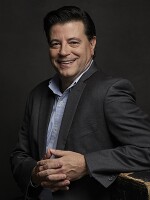When Puerto Rican-born artist Pablo Delano heard that the theme of the was “Foreigners Everywhere,” he contacted Adriano Pedrosa, the festival’s curator and artistic director, and requested that Puerto Rican artists be represented in the exhibition.
“Because we're the professional 'Foreigners Everywhere,'" Delano said. “There's nobody who has more foreigners everywhere than us, because we're neither here nor there. It's a pretty unique and bizarre situation. It's a nation that doesn't have nationhood. And so, I thought it was important that Puerto Rico be represented somehow in an exhibit titled 'Foreigners Everywhere.'"
“Of course, Puerto Rico can't have a national pavilion. Because it's not a nation, but it is a nation. Every Puerto Rican will talk about the Puerto Rican nation. There's a culture and language that’s unique, and yet we’re U.S. citizens, but that's constantly being questioned.”
Delano says before he was invited to participate in the 2024 Venice Biennale, he noticed that Adriano Pedrosa had visited his exhibit “The Museum of the Old Colony” at the Museum of Contemporary Art in San Juan, Puerto Rico, and had posted some pictures from the exhibit on his .
Delano was thrilled the Brazilian curator took notice of his work. In “The Museum of the Old Colony” Delano creates what he calls an “anti-museum,” or “performative museum,” using old museum tropes in an ironic way to not only highlight centuries of Puerto Rican colonialism, but question the purpose of museums themselves.

“As a child, I was fascinated by museums. I still love museums and love going to museums,” Delano said. “But I also had a strange and kind of lurid fascination with anthropology museums, and museums that attempt to tell the so-called 'story of mankind,' which is always about white supremacy, and how the white people civilized the dark people and so on. If you look at even the Museum of Natural History in New York City, back in the 20th century, they displayed live human beings as exhibits. A museum became almost a tool for othering, for furthering people that were seen as lesser behind glass or in dioramas, and figures. And so all of that scientific racism played a big part in my exhibit.”
Delano said soon after Pedrosa posted pictures of his exhibit, he was invited to show his work at the festival. Delano is a professor of Fine Art at Trinity College. He was on sabbatical during the fall semester, and has extended his sabbatical through the spring so he can travel to Venice and oversee the installation of his artwork, which Delano described as an “outgrowth of an older work” created in Hartford.
The runs from April 17 through Nov. 24 in various locations in Venice, Italy.





